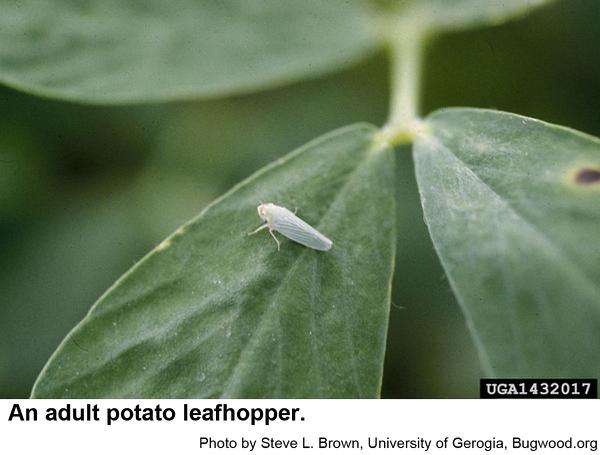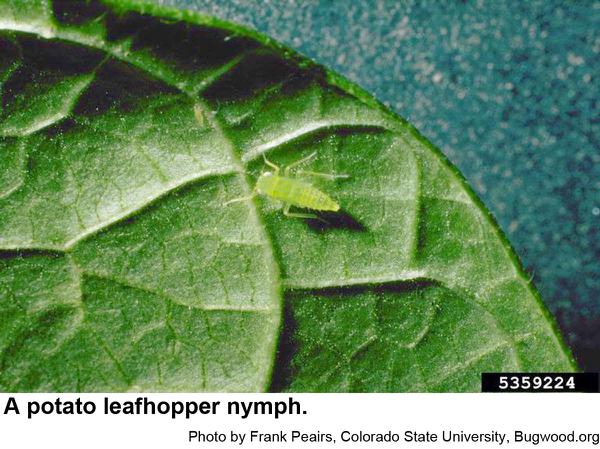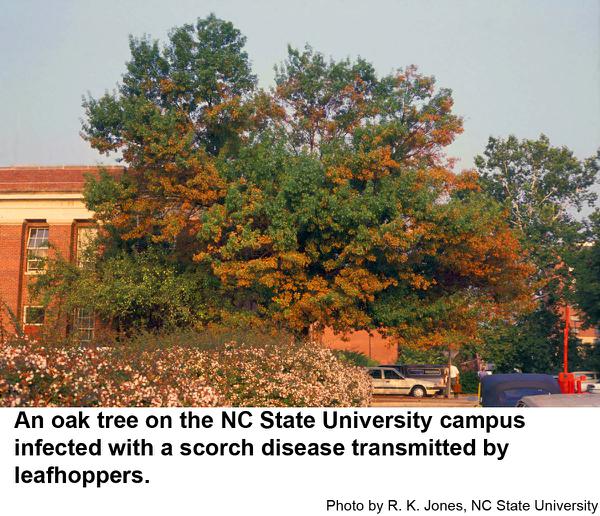Description and Biology
Adult potato leafhoppers, Empoasca fabae, are usually yellowish to pale green. Adults often have pale or dark green spots on the head, and six or more pale spots on the back immediately behind the head. Wings are held rooflike over the abdomen. Adults are about 1/8 inch long and wedge-shaped, tapering to the rear. Females insert their white to pale, slender, elongate eggs into leaf veins, petioles, and stems. Tiny nymphs hatch about 10 days later. Nymphs are similar in shape to the adults but are smaller and lack wings. They develop through five nymphal stages in about 2 weeks. Adults live about one month, but have been recorded as living as long as 120 days. Females mate within 2 days after their final molt and begin laying eggs about 6 days afterwards. An entire life cycle can be completed in as little as 4 weeks. Although found throughout North Carolina from mid May throughout the growing season, the potato leafhopper only overwinters along the Gulf Coast. It is carried northward by wind in spring and early summer and soon becomes well established. Although the potato leafhopper does not overwinter in North Carolina, it completes up to six generations here.
Host Plants
The potato leafhopper has been reported to feed on nearly 200 kinds of plants. Flowers attacked by the potato leafhopper include dahlia, marigold, rose, and sunflower. Host trees include Chinese chestnut, elm, English walnut, flowering Japanese cherry, hickory, locust, oak, and redbud. Flowering fruit trees, especially crabapple, are also hosts of potato leafhopper. Agricultural crops infested with this insect include alfalfa, apple, eggplant, peanut, potato, soybean, and sweet potato. Feeding and egg laying cause leaves to curl and stunt. Infested leaves turn yellow, or sometimes pink or purple, and wilt. Later, infested leaves brown and die. Larger nymphs cause most of the damage. Injection of saliva into the phloem during feeding may cause disease-like symptoms. Infested plants may exhibit a condition known as "hopperburn" in which there is a distortion of the leaf veins, yellowing of tissue around the margin and tip of the leaf, and eventual rolling and curling inward of the leaf. Floral development may be reduced or aborted.
Residential Recommendations
Because of their enormous feral population that is never treated with insecticides, potato leafhoppers are susceptible to almost any insecticide labeled for residential use. Follow the directions for safe use found on the label of whatever pesticide is used. Because leafhoppers fly readily, be aware that plants can be reinfested soon after a treatment.
References
- Common name: sharpshooters, leafhoppers, scientific name: Cicadellidae (Insecta: Hemiptera: Auchenorrhyncha: Cicadellidae). Tipping, C. and R. F. Mizell III. 2012, revised. Featured Creatures, Entomology & Nematology,FDACS/DPI,EDIS. Publication Number: EENY-334.
- Insect and Related Pests of Flowers and Foliage Plants. Baker, J. R. ed. 1994 (revised). N.C. Cooperative Extension Service publication AG-136.
- Potato Leafhopper. Walgenbach, J. 2015. NC State Extension, NC State Extension Publications.
- Extension Plant Pathology Publications and Factsheets
- Horticultural Science Publications
- North Carolina Agricultural Chemicals Manual
For assistance with a specific problem, contact your local N.C. Cooperative Extension center.
This Factsheet has not been peer reviewed.
Publication date: Feb. 23, 2018
Reviewed/Revised: Dec. 2, 2022
Recommendations for the use of agricultural chemicals are included in this publication as a convenience to the reader. The use of brand names and any mention or listing of commercial products or services in this publication does not imply endorsement by NC State University or N.C. A&T State University nor discrimination against similar products or services not mentioned. Individuals who use agricultural chemicals are responsible for ensuring that the intended use complies with current regulations and conforms to the product label. Be sure to obtain current information about usage regulations and examine a current product label before applying any chemical. For assistance, contact your local N.C. Cooperative Extension county center.
N.C. Cooperative Extension prohibits discrimination and harassment regardless of age, color, disability, family and marital status, gender identity, national origin, political beliefs, race, religion, sex (including pregnancy), sexual orientation and veteran status.



